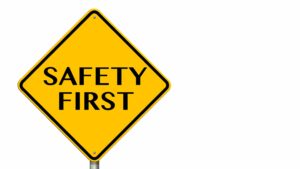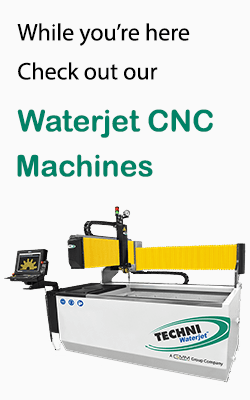Waterjet cutting technology is one of the most common methods whose applications you can find in a lot of different structures- from high-quality kitchen marble tops to industrial tools and processes.
If you look at the equipment that makes waterjet cutting possible, it looks very sophisticated and high-end. However, the history behind the process is older than you might have thought.
Here is a deeper insight into the origins of waterjet cutting technology and its evolution since then:
Who invented Waterjet Cutting?
It was Norman Franz who is credited with the first patent for a waterjet cutting machine He was a Professor at the University of British Columbia. His process used water at a pressure of 10,000 psi.
The history of waterjet cutting has its root in the mid 19th century, with the earliest application being the removal of clay and gravel deposits. The use of water jets for mining is termed as hydraulic erosion mining.
There are instances where waterjet cutting was used even in the 1850s in Russia and New Zealand, for the purpose of excavating coal mines.
Modified forms of waterjet cutting were also used for the mining of gold, to clear the gold veins from earth and stone impurities. Water pressure for these applications was just about 800 psi. In fact, the American gold rush gave a major boost to the use of waterjet technology for mining.
American and Russian engineers optimised the process to clean castings as well, in the 1930s. However, the pressure of water for these applications still wasn’t that high, at just about 1500 psi.
When were water jets invented?
There are different types of water jet cutters. These machines were pioneered at different times in history. Here is a timeline for the invention of different waterjet cutters:
When was pure water jet cutting developed?
The history of waterjet has been around since the 1850s for the purpose of mining. However, practical application of water jet cutting took place in the 1930s by paper companies to cut thick reams of paper.
The initial recorded application of waterjet was in 1933 when a paper company in Wisconsin used the process to cut horizontally moving reams of paper.
When was abrasive water jet machining developed?
Abrasive waterjet technology was developed mainly by an Egyptian-American engineer named Mohamed Hashish. These abrasive water jet cutters were very viable commercially and found their applications very quickly.
While abrasive waterjet cutting was present before Mohamed Hashish, the application of this technology was limited to wet blasting only. With Mohamed Hashish’s development, it was now possible to extend these applications for precision cuts.
When was liquid jet machining developed?
John Parsons improvised and developed liquid jet machining methods in the 1950s. These machines accomplished machining by using a pressure of 6900 bar. They were applied for the cutting of aerospace equipment and plastics.
When was the first commercial waterjet cutter introduced?
Waterjet cutters became available in the commercial market in the 1970s, introduced by Bendix Corporation.
Timeline of waterjet cutting developments
Here is a brief history of the development of waterjet cutting technology:
1930-1940
- Low-pressure waterjet cutting systems were applied for the cutting and processing in paper patents company. The technology to use a waterjet to cut paper was developed by Leslie Tirrell and Elmo Smith.
- While earlier waterjet cutting technology used for mining had very wide jet streams, the new waterjet cutters in the 1930s saw the development of narrow beams of waterjet stream.
- The major problem at this time involved finding a reliable high pressure pump that could create sufficient water pressures.
1940-1950
- The water pressure in waterjet cutters was increased and the cutting method was applied to the automotive and aviation sector.
1950-1960
- In 1956, Carl Johnson, working for Durox international in Luxembourg, innovated the technology so it could be applied to cut soft plastic shapes.
- In 1958, an aviation engineer developed waterjet cutters that could provide a pressure of 100000 PSI (6900 bar). These cutters were applied for the cutting of aerospace materials and plastics. This technology utilized hypersonic liquid jets that could pierce through alloys as well, including stainless steel.
- While the high pressure water was effective in cutting through hard materials, it also involved the problem of delamination of materials. Therefore, further modifications in the process were required.
- Norman Franz tries out initials runs of an abrasive waterjet machine. In his experiments, abrasive waterjet stream was used to cut lumber.
1960-1970
- Waterjet cutting started being applied to cut stone, metal, and polyethylene. The pressure of these waterjet cutters was lower (about 4000 bar).
- In 1962, an engineer of Union Carbide named Philip Rice experimented with the use of pulsating water jet cutters that worked at a pressure of about 50,000 psi.
1970-1980
- Bendix corporation launched a commercial waterjet cutting system that was available in the market. The major success of these cutters was the corundum crystal waterjet orifices developed by Bendix. These orifices could withstand very high water pressures.
- Mohamed Hashish creates a durable abrasive waterjet nozzle concept that can withstand the process of abrasive waterjet cutting. It revolutionised the industry and makes the abrasive waterjet cutting available for a wide variety of materials
1980-1990
- Boride Corp develops abrasive waterjet cutting nozzles of ceramic tungsten carbide material.
- Ingersoll-Rand became one of the major providers of abrasive waterjet cutters.
1990-2000
- Omax introduces a motion control system for water jet cutters that could move the water jet.
2000-2010
- Development of zero-tapper waterjet cutting that improves the accuracy of the process.
- Development of multi-axis (5-xis) waterjet cutting that could create complex incisions in the workpiece.
2010-present day
- Waterjet cutting incorporates a six axis facility, empowering these machines to create even more sophisticated shapes.
- Provision of tonnes of different software that are compatible with waterjet cutters. This software come with preloaded profiles for common cutting shapes.
Waterjet Cutting Technologies of the Future
One of the latest trends following in waterjet cutting is the development of smaller waterjet cutters. Smaller cutters ensure that fabricators can incorporate waterjet cutting into their existing workshop without overthinking about space requirements.
Development of smaller waterjet cutters also provides the option of small-scale fabricators offering the technology instead of speciality shops.
The speed of waterjet cutting is also one of the factors that is being improved upon. This can be done by increasing the water pressure and using more efficient software along with a high computing power.
Another area in which the technology is improving is in pushing the limits of the ultra high pressure water pump used in the process. These ultra high pressure water pump will break the boundaries of the technology, making it usable for even the thickest materials.
Endnotes
Even though waterjet cutting has already been around for more than a century, the process is still constantly evolving. Every industry is using waterjet cutting directly or using products made by this method.
If we look at the future trends, it will not be surprising to find waterjet cutters in the assembly line of most manufacturers. The application of the process to almost all materials add to the high demand for these machines.





